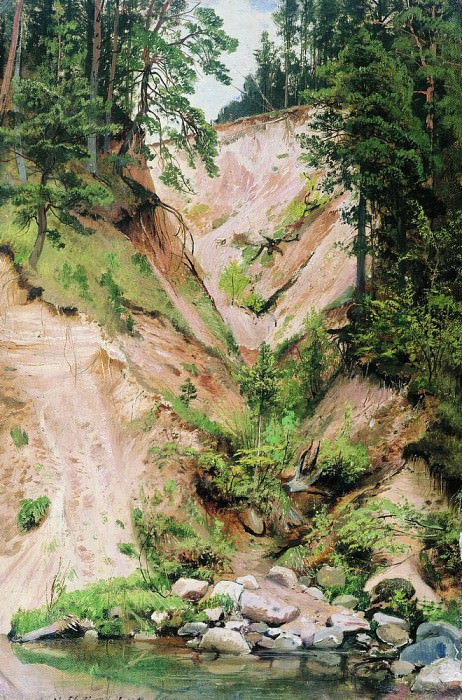Precipice (Ovrag. stream). 1883 64. 2h42 Ivan Ivanovich Shishkin (1832-1898)
Ivan Ivanovich Shishkin – Precipice (Ovrag. stream). 1883 64. 2h42
Edit attribution
Download full size: 660×1000 px (0,3 Mb)
Painter: Ivan Ivanovich Shishkin
Surprisingly beautiful landscapes are created by nature itself. It is the artist’s gift to see them and capture them. With Ivan Shishkin such paintings always turned out magnificent. After all, even on huge canvases he was able to prescribe branches, grass and leaves with almost photographic precision. And in the picture "precipice", we can see the ground, washed away by water, of which in some places stick out the roots.
Description of Ivan Shishkin’s painting "The Precipice".
Surprisingly beautiful landscapes are created by nature itself. It is the artist’s gift to see them and capture them. With Ivan Shishkin such paintings always turned out magnificent. After all, even on huge canvases he was able to prescribe branches, grass and leaves with almost photographic precision. And in the picture "precipice", we can see the ground, washed away by water, of which in some places stick out the roots. Here is a stump that has fallen into the bed of the ravine. Once it, apparently, still had its roots on the ground, but it was mercilessly washed away by the streams that rush here with every downpour, with every snow melt.
At the bottom of the precipice was a glaze of water. Probably the ravine descends to the river. That’s why the water rushed here so steadily, that it has dug such a ravine here over the centuries. And yet, at the bottom of the ravine, young trees have taken root and are growing and green in spite of everything.
There are many stones by the water. It is the mighty stream has rolled them here from above, from where the birches are trying to grow at the very edge, but it is difficult for them to grasp the ground, so they are bent, overhanging over the ravine.
Usually the author created such pictures by copying them from nature. He found magnificent places and went to them day after day, at the same hours, to catch almost the same state of nature, the same light.
"The precipice" he wrote on a clear summer day, when the ravine was dry and the exposed clay took on yellowish-orange hues. Shishkin painted tirelessly, working on several canvases simultaneously. His secret was that he had one painting at work - for morning hours, another - for daytime, and the third - for evening, when a penetrating misty haze could descend on the ground. And for each time of day he chose a suitable plan that looked best in a particular light.
Кому понравилось
Пожалуйста, подождите
На эту операцию может потребоваться несколько секунд.
Информация появится в новом окне,
если открытие новых окон не запрещено в настройках вашего браузера.
You need to login
Для работы с коллекциями – пожалуйста, войдите в аккаунт (open in new window).




















You cannot comment Why?
The artist has rendered the cliff face with meticulous detail, highlighting the texture of the soil and rock through varied brushstrokes. Patches of vibrant green foliage cling to the slopes, softening the harshness of the exposed earth. The trees at the top of the precipice are densely packed, their dark silhouettes contrasting against a lighter sky visible in the distance.
At the base of the cliff, a stream flows over a bed of rocks and pebbles. The water’s surface reflects the surrounding landscape, creating a sense of tranquility that contrasts with the imposing nature of the precipice above. A small area of grassy vegetation occupies the immediate foreground, providing a point of visual stability.
The painting conveys a feeling of solitude and the power of natural forces. The sheer scale of the cliff suggests the passage of time and the relentless erosion shaping the landscape. The absence of human presence reinforces this sense of isolation and emphasizes the dominance of nature. One might interpret the work as an exploration of geological processes, or perhaps as a meditation on the fragility of existence in the face of overwhelming natural power. The color palette, predominantly earthy tones punctuated by greens and blues, contributes to the overall mood of quiet contemplation and awe-inspiring grandeur.